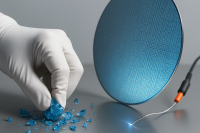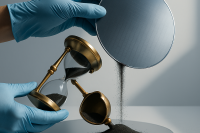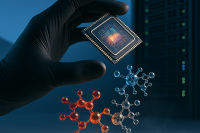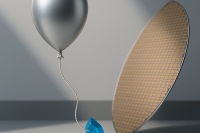IBM’s Loon Chip Signals Rapid Path to Fault-Tolerant Quantum Computing
Published Nov 16, 2025
On 12 November 2025 IBM announced the experimental Loon chip, which uses a cellular‐systems‐derived error‐correction approach and aims to help deliver useful quantum computers by 2029; alongside it IBM unveiled Nighthawk, slated for external research access by end‐2025 and expected to outperform classical computers on some tasks by late‐2026. About a week earlier IBM showed a quantum error‐correction algorithm running on AMD FPGAs at speeds 10× faster than demanded by performance needs. These developments matter because Loon’s design and FPGA integration could lower logical error rates and reduce the physical‐qubit overhead, accelerating timelines and pressing software, algorithm and infrastructure readiness. Immediate milestones to watch are Nighthawk public benchmarks in late‐2025 and external quantum‐advantage demonstrations by late‐2026.
1 ms Superconducting Qubit: Princeton's Tantalum Breakthrough Accelerates Fault-Tolerant Quantum Computing
Published Nov 16, 2025
On November 5, 2025, a Princeton University team led by Andrew Houck, Nathalie de Leon and Robert Cava reported in Nature a superconducting qubit made from tantalum on high‐purity silicon with coherence exceeding 1 ms—about three times longer than prior lab best (0.3–0.4 ms) and roughly 15× higher than many current processors. Longer coherence reduces error‐correction overhead and allows more operations before errors, improving prospects for fault tolerance; related devices showed T1 up to 1.68 ms, Q ≈ 1.5×10^7 (peaks 2.5×10^7) and single‐qubit fidelities of 99.994% (MIT reported 99.998%). Princeton projects that integrating this design into processors like Willow could yield ~1,000× performance gains. Immediate outlook: raise two‐qubit fidelities (target >99.9%), demonstrate logical‐qubit break‐even in 2026, and standardize tantalum‐on‐silicon fabrication in early 2026.
SUPREME Pilot Line Catalyzes Industrial-Scale Superconducting Quantum Chips
Published Nov 12, 2025
On 2025-07-09 the EU selected the SUPREME consortium, coordinated by VTT (Finland) with 23 partners across eight member states, to run Europe’s first pilot line for industrial-scale superconducting quantum chip fabrication, with three main sites including Garching and Munich and a goal to deliver validated high-yield processes and shared process design kits (PDKs) by 2027. Simultaneously, market financing accelerated: on 2025-11-03 Xanadu announced a $3.6 billion SPAC merger to list on Nasdaq and raise close to $500 million including $275 million in PIPE, while Israeli startup Qedma closed a $26 million Series A to commercialize error-mitigation software that it says can scale usable circuit sizes up to 1,000×. These moves matter because they combine capital and manufacturing scale to improve hardware readiness, support domestic supply chains, and expose risks in yield, coherence, and cost; immediate milestones to watch are SUPREME's 2027 PDK delivery and Xanadu's use of proceeds.
Quantum Leap: Millisecond Qubits, Helios, and DARPA's Benchmarking Push
Published Nov 12, 2025
In early November 2025 three coordinated advances shifted the quantum-computing landscape: on Nov 5 Princeton reported 2D transmon qubits with coherence >1 millisecond and 99.994% single-qubit fidelity using tantalum on high-resistivity silicon; on Nov 5 Quantinuum unveiled Helios, a 98‐qubit ion‐trap system with a 2:1 physical-to-logical ratio (48 logical qubits), 99.9975% single‐qubit fidelity and 99.921% two‐qubit fidelity, available via cloud and slated for installation in Singapore in 2026 alongside a new Python-embedded language for real‐time error correction; and on Nov 7 DARPA advanced 11 companies to Stage B of its Quantum Benchmarking Initiative (targeting utility-scale operation by 2033), including QuEra which may receive up to $15M for a 12‐month R&D plan. Together these developments make practical quantum error correction and scaling materially more achievable; Stage B work and Helios deployments are the immediate next steps.
Verifiable Quantum Advantage: Google's Willow and IBM's FPGA Error-Correction Breakthrough
Published Nov 12, 2025
On 2025-10-22 Google and IBM announced complementary quantum milestones that move the field toward practical use: Google’s 105-qubit Willow processor ran the new Quantum Echoes OTOC algorithm, producing verifiable expectation values (including NMR-inferred geometries for 15- and 28-atom molecules) and executing 13,000× faster than the best classical algorithm, while Willow reported single-qubit fidelity ~99.97%, entangling gates ~99.88% and readout ~99.5%; IBM demonstrated a quantum error‐correction routine running in real time on conventional AMD FPGAs at 10× the required speed, advancing its Starling roadmap toward 2029. These results matter because verifiability and faster, FPGA-enabled error correction make real applications (molecular modeling, materials, drug discovery) more plausible; next steps are scaling to logical qubits, external replication of Quantum Echoes and error‐correction results, and broader industry benchmarks, with Google projecting useful applications within five years.
Helios and Loon Spark Quantum Shift Toward Error-Corrected, Enterprise Computing
Published Nov 12, 2025
On Nov 5, 2025 Quantinuum commercially launched Helios, a 98 fully‐connected barium‐ion system claiming 99.9975% single‐qubit and 99.921% two‐qubit gate fidelity, offering 94 error‐detected logical qubits (50 used in magnetism simulations) and 48 fully error‐corrected logical qubits with 99.99% state preparation/measurement fidelity; Helios includes the Guppy Python language, NVIDIA GB200 via NVQLink, real‐time classical control, is available cloud and on‐premises, serves customers including Amgen, BMW, JPMorgan Chase, SoftBank and Sparrow, will be hosted in Singapore in 2026, and positions Quantinuum in DARPA’s QBI phase B toward a utility‐scale "Lumos" by 2033. A week later (Nov 12, 2025) IBM unveiled the experimental Loon chip—fabricated at Albany NanoTech—that adapts a cellphone‐signal algorithm for quantum error correction and, with Nighthawk due end‐2025, outlines a path to useful, error‐corrected machines by 2029 and some quantum‐advantage tasks by late 2026. These developments shift quantum computing toward enterprise utility and near‐term application testing.




